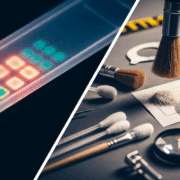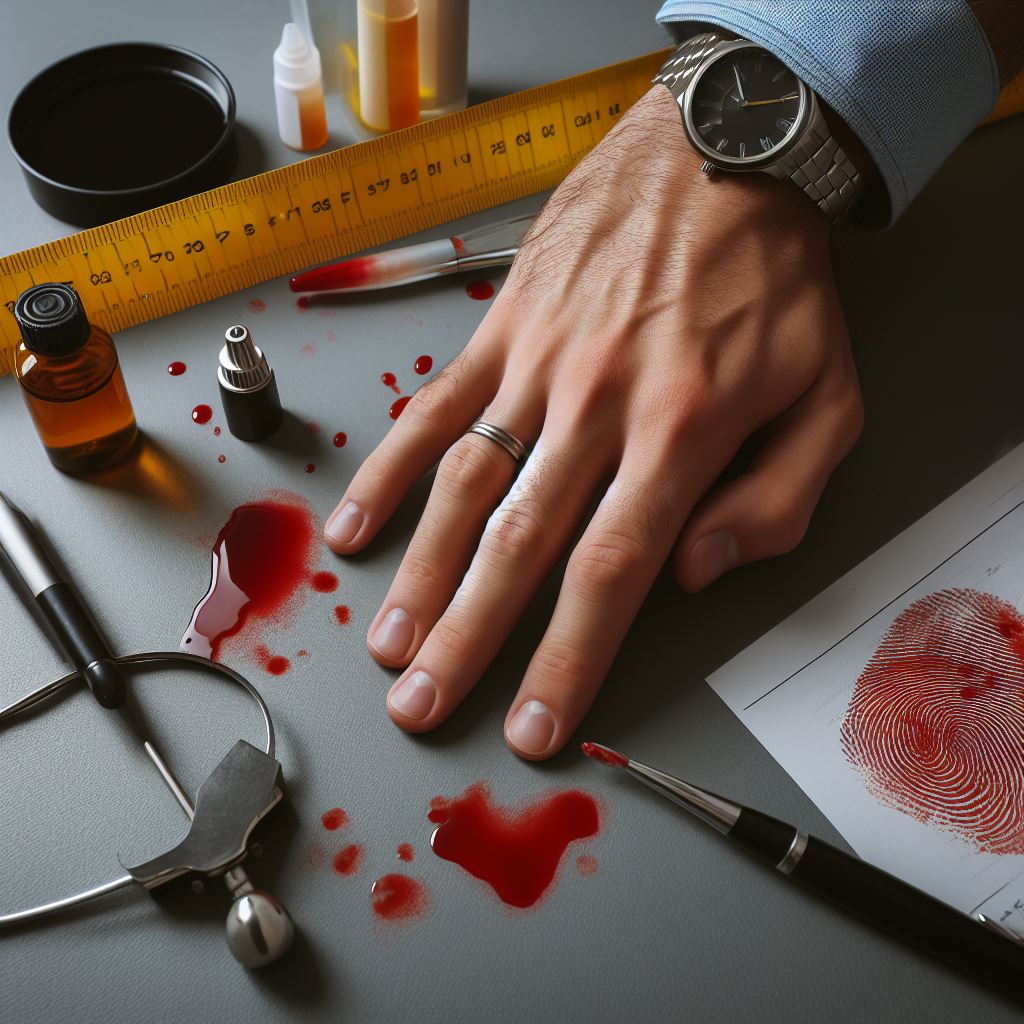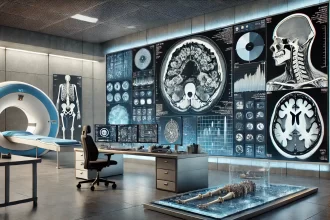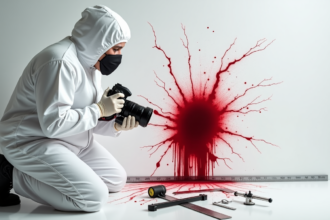Introduction
Silent witnesses speak volumes at crime scenes. Blood droplets scattered across surfaces tell stories that witness statements alone cannot reveal. Bloodstain pattern analysis decodes these stories, offering forensic experts powerful tools to reconstruct violent events and verify witness accounts. These crimson marks, each a piece of the puzzle, hold the potential to narrate the sequence of events, reveal the nature of the confrontation, and even pinpoint the movements of both victim and perpetrator.
- Introduction
- Historical Development of Bloodstain Pattern Analysis
- Scientific Foundations of Bloodstain Analysis
- Physics and Fluid Dynamics in Blood Behavior
- Mathematical Principles in Pattern Analysis
- Biological Properties of Blood Affecting Patterns
- BPA as a Narrative Tool
- Classification of Bloodstain Patterns
- Blood Behavior at Crime Scenes
- Crime Scene Documentation Methods
- Pattern Interpretation and Analysis
- Advanced Pattern Recognition
- Modern Technologies in BPA
- Quality Assurance in BPA
- Conclusion
- FAQs
- What are the main objectives of bloodstain pattern analysis in forensic investigations?
- How accurate is modern bloodstain pattern analysis?
- What role does technology play in contemporary bloodstain pattern analysis?
- How do environmental factors affect bloodstain evidence?
- What measures are taken to ensure quality and reliability in bloodstain pattern analysis?
The science of blood pattern analysis has matured significantly since its observational beginnings in the 1800s. Today, analysts examine blood evidence
This guide examines the core elements of modern bloodstain pattern analysis, exploring:
- Blood behavior principles and their forensic significance
- Pattern classifications and their investigative value
- Current analytical technologies and methods
- Essential documentation protocols
- Quality controlQuality control (QC) refers to a series of activities and measures conducted on individual laboratory tests or analyses to verify and ensure the accuracy and reliability of the results. QC is a reactive approach that Read Full Definition standards in pattern analysis
Each section builds upon fundamental concepts while highlighting practical applications in forensic investigations. Whether you’re a student exploring forensic science
Historical Development of Bloodstain Pattern Analysis
1895: Dr. Eduard Piotrowski
Dr. Piotrowski, working at the Institute for Forensic Medicine in Krakow, Poland, conducted the first documented study on bloodstain interpretation. His groundbreaking work, Uber Entstehung, Form, Richtung und Ausbreitung der Blutspuren nach Hiebwunden des Kopfes (On the Origin, Shape, Direction, and Distribution of Bloodstains Following Head Wounds Caused by Blows), laid the foundation for BPA. Piotrowski’s detailed experiments with blood dynamics demonstrated the importance of scientific methodology in interpreting bloodstain patterns.
1900: Dr. Paul Jeserich
Forensic chemist Dr. Jeserich in Berlin advanced the field by documenting bloodstain patterns at crime scenes. His work in the first decade of the 20th century focused on applying chemistry to homicide investigations.
1939: Dr. Victor Balthazard
Dr. Balthazard and his associates in France conducted seminal research on blood trajectories and patterns. They presented their findings, titled Etude Des Gouttes De Sang Projete (Research on Blood Spatter), at the 22nd Congress of Forensic Medicine. This research provided scientific insights into bloodstain trajectories.
1955: Dr. Paul Kirk
Dr. Kirk, a professor at the University of California, Berkeley, submitted an affidavit based on bloodstain evidence in the landmark case of State of Ohio vs. Samuel Sheppard. His analysis established the relative positions of the attacker and victim, marking a significant milestone for the legal recognition of BPA.
1971: Herbert Leon MacDonell
MacDonell, often referred to as the modern pioneer of BPA, conducted extensive research funded by the Law Enforcement Assistance Administration (LEAA). His publication, Flight Characteristics and Stain Patterns of Human Blood, provided a scientific foundation for understanding blood dynamics. MacDonell’s work led to the establishment of formal BPA training programs.
1973: First Formal Training in BPA
MacDonell introduced the first formal course on BPA in Jackson, Mississippi. His training manual, Laboratory Manual on the Geometric Interpretation of Human Bloodstain Evidence, became a foundational text for forensic education.
1982-1983: Expansion and Institutionalization
- 1982: MacDonell published Bloodstain Pattern Interpretation, expanding the field’s theoretical framework.
- 1983: The International Association of Bloodstain Pattern Analysts (IABPA) was established during MacDonell’s advanced BPA course, institutionalizing the discipline.
1989-1993: Key Publications
- Interpretation of Bloodstain Evidence at Crime Scenes (1989) by Dr. William G. Eckert and Stuart H. James offered practical case studies.
- Bloodstain Pattern Analysis — Theory and Practice (1990) by Ross Gardner and Tom Bevel provided a comprehensive manual for practitioners.
- Bloodstain Pattern Analysis in Violent Crimes (1993) by T. Paulette Sutton delivered a detailed guide for analyzing violent incidents.
1997-2001: Advances in Reconstruction
- Bloodstain Pattern Analysis with an Introduction to Crime Scene Reconstruction (1997) by Tom Bevel and Ross Gardner emphasized integrating BPA with broader forensic practices.
- Blood Dynamics (2001) by Anita Wonder offered advanced insights into the fluid mechanics of blood.
2004: Honorary Recognition
MacDonell received an honorary Doctor of Science degree from the University of Rhode Island, recognizing his contributions to BPA and forensic science.
Scientific Foundations of Bloodstain Analysis
Bloodstain Pattern Analysis (BPA) stands as a testament to the integration of scientific principles in forensic investigations, leveraging physics, mathematics, and biology to decode the silent testimony of blood at crime scenes. Blood, as a fluid governed by the laws of gravity and force, becomes a critical medium for reconstructing events. Each pattern—be it a droplet’s arc, the spread of a pool, or spatter—carries invaluable data Information in analog or digital form that can be transmitted or processed. Read Full Definition about velocity, direction, and volume, enabling forensic scientists to unravel the chronology of a crime scene.
Information in analog or digital form that can be transmitted or processed. Read Full Definition about velocity, direction, and volume, enabling forensic scientists to unravel the chronology of a crime scene.
Physics and Fluid Dynamics in Blood Behavior
Blood exhibits distinct fluid dynamic characteristics essential for pattern interpretation. Its unique composition, featuring both liquid and solid components, creates specific physical behaviors. For example, surface tension forces blood drops into nearly perfect spheres when they fall perpendicular to surfaces.
Blood movement follows precise"Precise" refers to the degree of closeness or consistency between multiple measurements or values taken under the same conditions. It indicates how well these measurements agree with each other, regardless of whether they are accurate Read Full Definition physical laws after leaving the body. Scientists have documented that blood drops reach terminal velocity at approximately 2.2 meters of fall height. These physical forces generate specific patterns that reveal:
- Trajectories: Mapping the path of blood in motion.
- Impact Dynamics: Assessing the force and direction of the event.
- Source-to-Target Relationships: Identifying the origin of blood relative to its landing site.
- Environmental Effects: Understanding how external factors, such as wind or surface texture, alter blood behavior.
Mathematical Principles in Pattern Analysis
Bloodstain geometry yields mathematical evidence crucial for scene reconstruction. Forensic analysts measure stain dimensions to calculate impact angles through trigonometric analysis [1]. These calculations unlock vital information about blood source locations and creation mechanisms.
- Impact Angle Determination: Bloodstain dimensions reveal angles of impact, providing clues about individuals’ positions and movements during the event. Impact angles leave distinctive mathematical signatures in bloodstain shapes.
- Circular Stains: Perpendicular impacts produce near-perfect circles.
- Elongated Stains: Angled impacts result in teardrop or elliptical shapes.
By applying these predictable mathematical relationships, forensic experts can trace blood trajectories back to their points of origin, offering a clearer narrative of the events.
Biological Properties of Blood Affecting Patterns
The biological composition of blood significantly influences its behavior and the resulting patterns. Key factors include:
- Components of Blood: Blood is a mixture of plasma, serum, red blood cells, white blood cells, platelets, and proteins.
- Clotting Process: Blood begins transitioning from a liquid to a gel within minutes of exposure to air, altering its interactions with surfaces and creating temporal markers for injury timing.
- Surface Interactions: The surface’s texture and absorbency impact the bloodstains’ spread and shape. When examining bloodstain formation on various materials. They must also understand how blood’s physical properties change outside the body to interpret patterns on materials such as fabric, glass, or concrete accurately.
BPA as a Narrative Tool
The synergy of physics, mathematics, and biology transforms BPA into a powerful tool for storytelling in criminal investigations. Blood patterns offer insights that words alone cannot, reconstructing:
- Sequences of Events: Unraveling what happened and in what order.
- Action Dynamics: Identifying movements and interactions of individuals.
- Environmental Context: Understanding the influence of the surroundings on the crime scene.
Classification of Bloodstain Patterns
Forensic scientists organize bloodstain patterns into three distinct categories. Each category reveals specific aspects of violent incidents, allowing analysts to evaluate crime scene evidence systematically and reconstruct events precisely.
Impact and Spatter Patterns
External forces striking liquid blood create characteristic impact spatter patterns. The force magnitude determines the pattern characteristics. High-velocity impacts generate mist-like patterns measuring less than 1 millimeter, while medium-velocity impacts create larger droplets ranging from 1 to 4 millimeters. Blood projection direction proves equally telling—the back spatter moves against the force direction while the forward spatter travels along it.
Transfer and Contact Patterns
Blood-soaked surfaces contacting clean surfaces leave transfer patterns that document object movement and event sequences. Microscopic analysis of fabric transfer patterns reveals distinctive characteristics. Spatter stains show equal distribution between left and right loop legs, yet contact transfer patterns demonstrate a marked 82% preference for left loop legs. These microscopic differences guide analysts in pattern classification.
Flow and Pool Patterns
Gravity shapes flow and pool patterns, offering vital clues about victim positioning and movement. Pooled blood indicates stationary bleeding, while flow patterns trace blood movement across surfaces. These patterns reveal:
- Bleeding duration
- Positional shifts
- Movement patterns
- Time progression
The Scientific Working Group on Bloodstain Pattern Analysis maintains strict pattern definitions. Their guidelines distinguish transfer stains, created by surface contact, from spatter stains, formed by airborne blood droplets. This standardization ensures consistent analysis across forensic investigations.
Pattern classification faces ongoing challenges. Analysts report difficulty with ambiguous patterns showing overlapping characteristics. The field continues moving toward objective, characteristic-based classification methods to enhance accuracyIn scientific and measurement contexts, "accuracy" refers to the degree of proximity or closeness between a measured value and the true or actual value of the measured quantity. Accuracy indicates how well a measurement reflects Read Full Definition and minimize analytical biasThe difference between the expectation of the test results and an accepted reference value. Read Full Definition.
Types of Bloodstains
Diving into the taxonomy of bloodstains reveals a lexicon of violence and struggle, where each type serves as a clue to the underlying actions:
- Single Drop: The simplicity of a drop falling straight down can tell tales of height and force.
- Impact Spatter: Resulting from the violent meeting of force and blood, this pattern can indicate the nature and direction of the impact.
- Cast-Off Stain: Tells of the rhythm of violence, each arc a testament to the movement of the weapon.
- Transfer Bloodstains: The silent witnesses of contact, leaving imprints of skin, fabric, or tools, providing links between victim, perpetrator, and scene.
- Projected Pattern/Arterial Damage Stain: These patterns are dramatic and telling, charting the pulsating ejection of blood, offering insights into the location and severity of injuries.
- Pool Stains: The gravity of injuries is often reflected in the accumulation of blood, providing clues to the duration and intensity of the bleeding.
- Insect Stains: Nature’s inadvertent participants, insects can alter bloodstain patterns, introducing variables that require careful interpretation.
- Expiration Stains: Breathed out in moments of distress, these stains are both delicate and revealing, often associated with internal injuries.
Blood Behavior at Crime Scenes
Blood evidence presents unique challenges in modern forensic investigations. Crime scene analysts must account for numerous variables that alter bloodstain evidence characteristics. Today’s crime scenes feature complex environments and advanced materials, each introducing distinct challenges for blood pattern interpretation.
Environmental Effects on Blood
Blood evidence responds dramatically to environmental conditions. Heat hastens blood drying processes, while cooler temperatures preserve liquid states longer [8]. Moisture levels similarly affect evidence preservation – high humidity extends drying periods, while dry conditions accelerate the process [8]. Air currents across bloodstains further complicate preservation efforts, as increased airflow speeds up drying rates [8].
Surface Interactions
Today’s crime scenes showcase an array of sophisticated surfaces. Forensic analysts encounter blood evidence on modern materials ranging from oleophobic smartphone screens to specialized windshield coatings [9]. Each surface type affects blood behavior distinctly:
- Blood dries rapidly on non-porous materials, leaving minimal absorption
- Fabric and carpet fibers trap blood, creating extended drying periods [8]
- Water-repellent surfaces produce unexpected stain patterns
Time-Related Changes
Blood begins its transformation sequence the moment it leaves the body. Clotting mechanisms activate within minutes [10], triggering a series of observable changes:
- Fresh blood develops a dark, glossy gel consistency
- Chemical and physical properties shift progressively [11]
- Oxyhemoglobin degradation follows specific decay patterns [11]
Scientists have achieved 70% accuracy in aging bloodstains up to two years old [12]. This temporal data strengthens crime scene reconstruction efforts and helps verify witness accounts. Studies show optimal aging analysis occurs at 25°C with 90% humidity, producing distinctive metabolite patterns [13].
Current analytical techniques differentiate bloodstains by age – from hours to years old [12]. This capability enables more precise incident timeline construction, though results vary based on environmental factors and surface properties.
Crime Scene Documentation Methods
Meticulous documentation serves as the foundation of reliable bloodstain pattern analysis. Forensic experts follow rigorous protocols to preserve blood evidence, ensuring its value for both analytical work and legal proceedings.
Photography and Video Documentation
High-resolution photography remains the gold standard for bloodstain evidence capture. The ‘roadmapping’ technique, pioneered by Toby L. Wolson at the Miami-Dade Police Department’s Crime Laboratory, offers systematic photographic guidelines [23]. Key photographic elements include:
- Scene-wide shots prior to evidence marking
- Relationship-focused medium-range images
- Scaled close-up photographs
- Pattern group sequential documentation
- Individual stain detailed records
Video records add dynamic perspectives to still photography documentation. Proper timing proves crucial – video documentation occurs after scene survey but before evidence manipulation [24].
Measurement and Mapping Techniques
The photographic grid technique delivers precise bloodstain pattern documentation through structured steps:
- Zero point establishment at wall intersections
- Floor-to-ceiling measurements in one-foot increments
- Grid creation with vertical and horizontal lines
- Cell identifier assignment
- Metric scale placement [25]
‘Roadmapping’ protocols specify essential tools – yellow paper scales, mapping symbols, and 50mm/2-inch adhesive scales [23]. This methodical approach enables thorough evidence review by analysts unable to visit the original scene.
Digital Evidence Collection
Modern documentation merges traditional expertise with digital precision. Analysts capture vital scene dimensions, evidence relationships, and surface characteristics affecting bloodstain patterns [26]. Quality documentation demands professional-grade cameras, specialized lighting, and precise measurement instruments [1].
Bloodstain pattern photography requires multiple angles, with cameras positioned perpendicular to surfaces for individual pattern capture [26]. This thorough digital record supports both immediate analysis needs and future evidence review requirements.
Pattern Interpretation and Analysis
Bloodstain pattern interpretation demands both mathematical precision and forensic expertise. Expert analysts decode blood evidence through systematic examination, revealing crucial details about violent incidents and enabling accurate crime scene reconstruction.
Determining Point of Origin
Blood droplet paths tell compelling stories about their origins. Pattern analysts locate the convergence area where these paths intersect, marking the blood source location. The stringing method guides this process – analysts extend strings along impact directions from bloodstain positions [2]. Mathematical precision enters through the angle of impact formula: sin(A) = width/length, yielding vital height calculations [2].
Reconstructing Event Sequences
Overlapping stains and pattern characteristics reveal the timeline of violent events. Blood velocity signatures mark distinct incident phases:
- High-velocity spatter (>100 feet/second) yields droplets ≤1mm, signature marks of gunshot wounds [2]
- Medium-velocity impacts (5-25 feet/second) create 1-4mm droplets, indicating blunt force trauma [2]
- Low-velocity patterns emerge through gravitational forces, producing larger drops [2]
Velocity and Force Calculations
Blood droplets tell mathematical stories of force and impact. Surface strikes follow four distinct phases: contact and collapse, displacement, dispersion, and retraction [27]. Terminal velocity creates predictable patterns, enabling precise force and distance calculations.
Scientific studies reveal important limitations – traditional trajectory methods overestimate origin points by roughly 50% when ignoring gravity and drag forces [28]. Modern analytical approaches incorporate fluid dynamics and statistical uncertainty, particularly crucial for impacts beyond one meter from target surfaces [28].
Pattern interpretation accuracy faces ongoing scrutiny, with research documenting an 11.2% analystA designated person who examines and analyzes seized drugs or related materials, or directs such examinations to be done; independently has access to unsealed evidence in order to remove samples from the evidentiary material for Read Full Definition error rate [29]. Forensic experts respond through objective classification systems and rigorous peer review protocols, strengthening analytical reliability.
Advanced Pattern Recognition
Digital technologies herald a new era in bloodstain pattern analysis. Pattern recognition algorithms now augment expert interpretation, offering enhanced precision while reducing human bias in evidence examination.
Machine Learning Applications
Artificial Intelligence stands at the forefront of modern bloodstain analysis. The Segment Anything Model (SAM) excels at bloodstain segmentation, achieving 97.8% accuracy through point and bounding box prompts [14]. SAM retains robust performance with grayscale images, maintaining 87.8% accuracy [14].
Neural networks demonstrate exceptional capabilities in pattern identification:
- Convolutional Neural Networks (CNN)
- Random Forest classifiers
- Decision Tree algorithms
- Extreme Learning Machine (ELM) systems
Pattern Classification Systems
Digital classification platforms merge expert knowledge with computational power. SAM’s refined model examines individual blood droplets in 2.39 seconds, marking a 4.7% speed improvement over earlier versions [14]. Such efficiency proves vital for processing extensive crime scenes without sacrificing analytical quality.
Statistical Analysis Methods
Statistical rigor underpins modern bloodstain examination. Automated systems showcase impressive pattern identification capabilities – Random Forest classifiers achieve 80% accuracy in pattern differentiation [15]. Hyperspectral imaging coupled with ELM algorithms excels at species-specific bloodstain identification [16].
Yet challenges persist. Traditional analytical methods show 20% higher misclassification rates when contextual information sways pattern interpretation [17]. Scientists respond by developing objective, characteristic-based systems that minimize analyst bias and strengthen interpretative consistency.
Digital analysis tools continue evolving, offering specialized software for crime scene interpretation. These platforms unite machine learning capabilities with established analytical methods, creating robust frameworks for pattern recognition and classification.
Modern Technologies in BPA
Digital innovation reshapes bloodstain pattern analysis daily. Crime scene investigations benefit from sophisticated tools that sharpen precision and strengthen reliability. These technological advances fundamentally alter how forensic experts approach blood evidence examination.
3D Scanning and Digital Documentation
Three-dimensional laser scanning technology stands among the most significant advances in bloodstain documentation. Modern scanners capture millions of accurate data points, generating precise digital crime scene models [18]. This technology empowers analysts through:
- Point cloud model generation
- Virtual scene navigation
- Evidence relationship preservation
- Remote collaborative analysis
Mock jury studies reveal compelling results – participants shown 3D point cloud presentations retain evidence details better and show heightened engagement with forensic testimony [18].
Computer-Aided Pattern Analysis
Digital analysis platforms redefine bloodstain interpretation capabilities. Forensic laboratories now access fifteen specialized software packages for trajectory analysis, six of which show documented success in actual cases [19]. These tools automate measurements and calculations, dramatically reducing analysis time compared to manual methods.
Python-based solutions excel at detecting minute stains while calculating advanced fluid mechanics metrics [20]. When combined with 3D scan data, these applications achieve remarkable accuracy in blood origin determination and trajectory mapping.
Advanced Imaging Techniques
Hyperspectral imaging (HSI) marks a crucial advancement in bloodstain identification science. This technology merges spatial and spectral data, enabling swift analysis without sample preparation [21]. Systems operating at 400-1000 nm with 5 nm resolution excel at differentiating human bloodstains from animal sources [16].
Infrared techniques prove particularly valuable for dark fabric examination. Studies confirm IR systems detect significantly more bloodstains than traditional white light methods [22]. While higher resolution systems offer superior detection capabilities, analysts must weigh these benefits against practical field requirements.
These technological tools strengthen both accuracy and objectivity in bloodstain pattern analysis. The fusion of digital capabilities with traditional methods creates robust frameworks for crime scene reconstruction and courtroom presentation.
Quality Assurance in BPA
Quality standards stand as guardians of scientific integrity in bloodstain pattern analysis. Scientific studies spotlight both achievements and shortcomings in current practices, pointing toward necessary procedural refinements.
Standard Operating Procedures
Forensic laboratories must maintain robust quality assuranceQuality assurance (QA) is a comprehensive set of activities and processes to ensure the overall quality and reliability of the work conducted within a laboratory. QA is a proactive approach that focuses on improving scientific Read Full Definition programs for bloodstain analysis. Essential program elements include:
- Documented goals and objectives
- Personnel qualification criteria
- Evidence handling protocols
- Equipment and reagent standards
- Report writing guidelines
- Safety protocols
Agencies document each procedure meticulously, from scope definition to analytical methods [30]. This structured approach safeguards evidence integrity across investigations.
Validation and Verification Methods
New analytical techniques undergo rigorous testing before implementation. The validationValidation, often referred to as method validation, is a crucial process in the laboratory when introducing a new machine, technology, or analytical technique. It involves a series of systematic steps and assessments to ensure that Read Full Definition process demands:
- Control sampleControl sample - material of a known source that presumably was uncontaminated during the commission of the crime. Read Full Definition evaluation
- SpecificityIn the context of laboratory equipment or analytical techniques, the term "specific" describes the capability of a machine or method to accurately and selectively detect particular molecules or substances while minimizing interference from others. Specificity Read Full Definition and sensitivityIn the context of laboratory equipment or analytical techniques, the term "sensitive" describes the capability of a machine or method to detect even very small amounts or concentrations of a substance. Sensitivity is a quantitative Read Full Definition testing
- Accuracy and reliability assessment
- Limitation documentation
- Peer review completion
Procedure modifications trigger mandatory revalidation of affected components [31]. This requirement upholds scientific standards throughout casework applications.
Error Rate Assessment
Large-scale research reveals crucial accuracy metrics in bloodstain analysis. Studies examining 75 practicing analysts uncovered an 11.2% error rate when analyzing known-cause bloodstains [32]. Result reproducibility poses additional challenges – different analysts reach contradicting conclusions 7.8% of the time [33].
Contextual bias shapes analytical outcomes significantly. Analysts achieve 8% error rates with accurate contextual scenarios on rigid surfaces [34]. Misleading scenarios, however, drive error rates up to 20% [34]. These findings emphasize blind analysis importance.
Technical reviews show concerning patterns. When one analyst errs, second analysts reproduce that same error 18% to 34% of the time [32]. Such error correlation patterns demand stronger quality control measures.
The field advances through development of objective, characteristic-based classification systems. These refinements target reduced subjective interpretation, strengthening bloodstain pattern analysis reliability in forensic work [35].
Conclusion
Bloodstain pattern analysis merges scientific precision with technological advancement to unlock crime scene mysteries. Expert examination of blood evidence characteristics enables analysts to map violent events, pinpoint blood origins, and test witness statements with scientific accuracy.
Three core elements define modern bloodstain analysis: scientific rigor, systematic documentation, and digital innovation. Pattern recognition algorithms demonstrate unprecedented 97.8% accuracy rates, while 3D scanning creates exact crime scene replicas. These tools amplify traditional forensic expertise, offering investigators deeper insights into violent incidents.
Scientific studies highlight ongoing challenges, notably the 11.2% error rate in analyst conclusions. This finding fuels methodological improvements across the field. Research teams focus on developing objective classification systems and enhanced validation protocols, targeting reduced contextual bias and stronger pattern interpretation.
Bloodstain pattern analysis grows stronger through scientific discovery, procedural refinement, and enhanced understanding of blood dynamics. These advances cement BPA’s position as a cornerstone of forensic science, enabling investigators to extract vital evidence from violent crime scenes and support justice through methodical scientific analysis.
FAQs
What are the main objectives of bloodstain pattern analysis in forensic investigations?
Bloodstain pattern analysis aims to reconstruct crime scenes, determine the sequence of events, identify the type of weapon used, and validate or challenge witness accounts. It provides crucial information about what happened during violent incidents by examining the size, shape, location, and distribution of blood evidence.
How accurate is modern bloodstain pattern analysis?
Modern bloodstain pattern analysis combines traditional expertise with advanced technologies, achieving high accuracy rates. Machine learning algorithms can reach up to 97.8% accuracy in pattern recognition. However, studies show that human analysts still have an error rate of approximately 11.2% when examining bloodstains with known causes.
What role does technology play in contemporary bloodstain pattern analysis?
Technology has significantly enhanced bloodstain pattern analysis. 3D scanning creates detailed digital crime scene models, computer-aided analysis software streamlines interpretation, and advanced imaging techniques like hyperspectral imaging improve bloodstain detection and identification. These tools increase precision and objectivity in forensic investigations.
How do environmental factors affect bloodstain evidence?
Environmental conditions such as temperature, humidity, and airflow significantly impact bloodstain evidence. Higher temperatures and lower humidity accelerate blood drying, while higher humidity extends drying times. Surface characteristics also play a crucial role, with porous materials absorbing blood and extending drying time compared to non-porous surfaces.
What measures are taken to ensure quality and reliability in bloodstain pattern analysis?
Quality assurance in bloodstain pattern analysis involves implementing standard operating procedures, conducting thorough validation and verification of methods, and assessing error rates. Forensic agencies maintain documented quality assurance programs, perform developmental and internal validation of techniques, and increasingly rely on objective, characteristic-based classification systems to enhance accuracy and reliability.
References
[1] – https://www.sirchie.com/media/resourcecenter/item/s/i/simplifiedguidebloodstainpatterns.pdf
[2] – https://accessdl.state.al.us/AventaCourses/access_courses/forensic_sci_ua_v17/06_unit/06-01/06-01_learn_text.htm
[3] – https://gaiai.org/wp-content/uploads/2024/04/Principles-of-Bloodstain-Patter-Analysis-1.pdf
[4] – https://www.news-medical.net/life-sciences/What-is-Bloodstain-Pattern-Forensic-Analysis.aspx
[5] – https://en.wikipedia.org/wiki/Bloodstain_pattern_analysis
[6] – https://www.sciencedirect.com/science/article/abs/pii/S0379073815000353
[7] – https://www.forensicsciencesimplified.org/blood/glossary.html
[8] – https://www.sciencedirect.com/science/article/pii/S1355030624000546
[9] – https://www.forensic-access.co.uk/news/news/the-intricacies-of-blood-pattern-analysis-in-forensic-investigations/
[10] – https://www.bu.edu/eng/2023/10/23/improving-the-science-behind-bloodstain-pattern-analysis/
[11] – https://www.forensicsciencesimplified.org/blood/BloodstainPatterns.pdf
[12] – https://pmc.ncbi.nlm.nih.gov/articles/PMC8540217/
[13] – https://nij.ojp.gov/library/publications/predicting-time-crime-bloodstain-aging-estimation-two-years
[14] – https://www.sciencedirect.com/science/article/abs/pii/S0013935122020709
[15] – https://ar5iv.labs.arxiv.org/html/2308.13979
[16] – https://www.sciencedirect.com/science/article/abs/pii/S0379073824003608
[17] – https://www.spectroscopyonline.com/view/cutting-edge-vis-nir-hyperspectral-imaging-enhances-bloodstain-identification-in-forensic-science
[18] – https://link.springer.com/article/10.1007/s13218-022-00760-y
[19] – https://www.sciencedirect.com/science/article/pii/S1355030624000340
[20] – https://www.sciencedirect.com/science/article/pii/S0379073821003121
[21] – https://www.sciencedirect.com/science/article/abs/pii/S0379073824002810
[22] – https://pmc.ncbi.nlm.nih.gov/articles/PMC8123592/
[23] – https://www.sciencedirect.com/science/article/pii/S0379073821004448
[24] – https://www.ojp.gov/ncjrs/virtual-library/abstracts/documenting-bloodstain-patterns-through-roadmapping
[25] – https://www.crime-scene-investigator.net/phoblood.html
[26] – https://www.ojp.gov/ncjrs/virtual-library/abstracts/using-photographic-grid-documentation-bloodstain-patterns-crime
[27] – https://www.sbsheriff.org/wp-content/uploads/2019/12/SOP-CSI-009-12-Bloodstain-Pattern-Analysis.pdf
[28] – https://www.sciencedirect.com/science/article/abs/pii/S0379073818307928
[29] – https://nij.ojp.gov/topics/articles/study-reports-error-rates-bloodstain-pattern-analysis
[30] – https://www.nist.gov/document/bpastandardsforqualityassuranceprograminbloodstainpatternanalysispdf
[31] – https://www.nist.gov/system/files/documents/2017/11/15/bpa_standard_for_the_validation_of_procedures_in_bloodstain_pattern_analysis.pdf
[32] – https://nij.ojp.gov/library/publications/study-reports-error-rates-bloodstain-pattern-analysis
[33] – https://www.sciencedirect.com/science/article/pii/S0379073821001766
[34] – https://www.crime-scene-investigator.net/reliability-assessment-of-current-methods-in-bloodstain-pattern-analysis.html
[35] – https://nij.ojp.gov/topics/articles/study-assesses-accuracy-and-reproducibility-bloodstain-pattern-analysis











